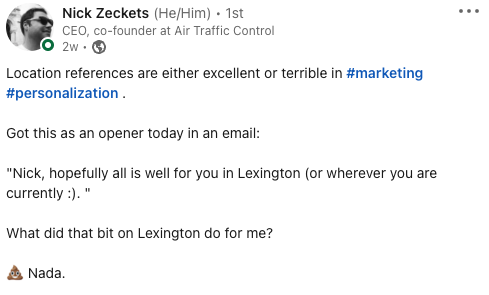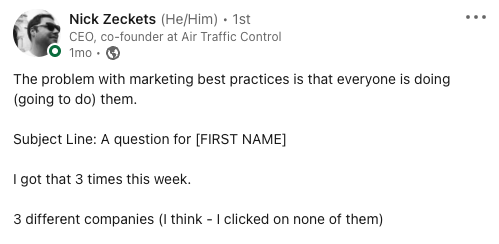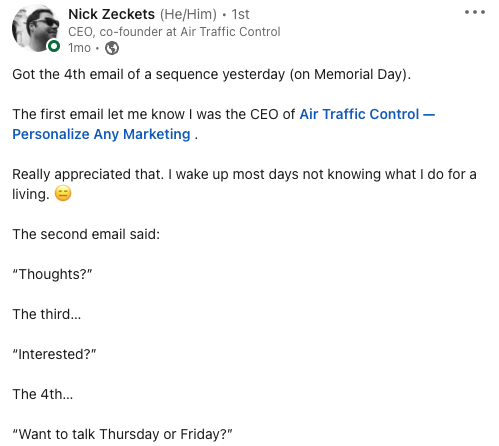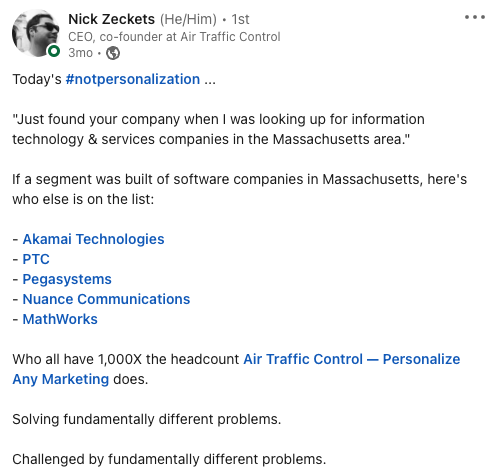In today's digital-first B2B landscape, understanding buyer intent has become more crucial—and more complex—than ever. As buying committees..

Why is personalized marketing so hard?
In a world where our digital footprint reveals more about us than we might realize, the power of personalized marketing has never been more apparent. However, if you've ever dipped your toes into the complex currents of this marketing approach, you'd know that it's anything but easy.
Personalized marketing is the fine art of tailoring messages, offers, and experiences to individuals based on their preferences and behaviors. It's like hosting a dinner party and remembering that Sarah doesn't eat gluten, while John is a die-hard fan of your signature lasagna. It's about making your guests - or in our case, customers - feel understood and valued.
But here's the catch.
Implementing personalized marketing effectively in B2B Marketing and Sales, especially at scale, feels like running air traffic from the tower at O’Hare with no radar. Between outdated segmentation methods, overemphasis on content creation, and labyrinthine logic rules, true personalization can feel elusive. So, why is personalized marketing so hard?
Let's explore this conundrum together and get your radar turned on.
The Importance and Potential of Personalized Marketing
Before we dive into the challenges, let's remind ourselves why we're in the control tower in the first place: the potential of personalized marketing.
Research continues to show that personalized experiences drive customer engagement, loyalty, and ultimately, revenue. According to Epsilon, 80% of consumers are more likely to make a purchase when brands offer personalized experiences. Not only that, personalization can deliver 5-8x times the ROI on marketing spend and can lift sales by 10% or more.
Take Spotify, for instance. Their individualized playlists like "Discover Weekly" and "Daily Mix" have become industry standards for personalized marketing. It's like having a friend who knows your music taste so well that they can introduce you to your new favorite band before you've even heard of them.
And yet, despite these impressive stats and success stories, many of us are still wrestling with the execution of personalized marketing. At airtrafficcontrol.io, we've observed that this struggle often stems from an over-reliance on traditional marketing methods and a misunderstanding of what true personalization should feel like for the most important people: our customers.
Now, let's dig into these common pitfalls and shed light on why personalized marketing can be such a hard nut to crack.
The Pitfalls of Current Personalized Marketing and Sales Strategies
The irony is that the technology designed to help us scale our marketing efforts often pushes us towards unproductive practices that lead to poor personalization.
Segmentation, while probably better than saying the same thing to everyone, is oversold as personalization. More unique? Yes. But it still isn't about people. Worse, yet, maintaining the plumbing of [CONTENT A] is shown to [SEGMENT A] is a compounding debt.
Difficult to maintain and harder, yet, to improve on.
For example, the shotgun approach of sending generic outbound emails to broadly segmented contact lists has become all too common. We blanket our audience with the same messages, hoping that something will resonate. However, these attempts at "personalization" are as personal as calling everyone at your dinner party 'guest'; it's impersonal, ineffective, and downright disappointing.
Moreover, we've become dependent on superficial personalization tokens, using information like industry and title to tailor our messages.
But let's be honest - telling someone what they already know about themselves isn't exactly groundbreaking. It's like offering John, our lasagna-lover, a plate of noodles and saying, "You work in IT, so you must love these." It just doesn’t add up.

Here are some go-to "personalization tactics" in B2B marketing and sales that land companies in the trash folder:
Which btw, all include some form of 'Hi, [FIRSTNAME], I see that you're the [TITLE] of [COMPANY.]"
Irrelevant location references...

Nothing unique...

Stuff we already know about ourselves (also irrelevant to the value prop)...

Bad segmentation...

I could go on about the "personalization trash" in my inbox. We have to do better.
True personalization goes beyond these one-size-fits-all tactics. It's about tapping into deeper insights that allow us to engage our audience on a more meaningful level.
Let's explore the challenges that come with achieving this level of personalization.
The Challenges of TRUE Personalized Marketing for B2B Orgs
Achieving authentic personalization is like navigating a minefield, with obstacles at every turn. Let's break down the key challenges:
Challenge 1: Generic Audience Segments
Our traditional understanding of our ideal customers is often too generic. Marketers usually segment audiences based on superficial details like job title, industry, or company size, but true personalization requires going deeper. For personalization to be successful, it needs to be data-informed with UNIQUE data, not just to tell customers things they already know but to highlight data from their industry or competitors that show business impact and encourage them to take action.

Personalization Challenge 2: Content Overload
The misconception that content marketing and personalization require a tremendous amount of content has led marketers down a content creation rabbit hole. The key isn't to create more content, but to create the RIGHT content and repurpose it effectively.
Smarter personalization strategies informed by data can reduce content creation, increase content repurposing and make campaigns evergreen. All which helps towards the need of being super efficient because scalable growth is the key to success.

Personalization Challenge 3: Content and People Tagging
The manual effort of tagging content by broad categories and contacts is not only labor-intensive but also insufficient for powering true personalization because it can be subjective and error prone.
AI can be leveraged to understand your content and audience engagement more precisely and match them more accurately.

Personalization Challenge 4: Building Logic Rules
Deciding 'who gets what and when and how often' is a complicated task that leaves many marketers in a tangle. Crafting the perfect delivery system that is personal yet non-invasive can be a Herculean task.

Personalization Challenge 5: Designing End-to-End Campaigns
Designing a comprehensive campaign that integrates all these elements can feel like trying to assemble a machine with mismatched parts. The end product often ends up being a generic campaign that doesn't deliver results and requires repetition.
Despite these challenges, achieving true personalization isn't an unattainable dream. In fact, the quest for efficiency and effectiveness in marketing has never been more crucial. And, as we'll explore next, personalization can have a multiplier effect across all your engagement channels and conversion rates, helping you generate pipeline while utilizing your resources efficiently.

The Power of True Personalization: Enter airtrafficcontrol.io
The truth is, personalization doesn't need to be a Herculean task. With the right tools, you can deliver deeply personalized experiences that leave your customers feeling valued and understood.
Enter airtrafficcontrol.io - your co-pilot in the journey towards true personalization.
At airtrafficcontrol.io, we understand the barriers to personalization and have designed a solution to help you navigate through them. Our tool seamlessly integrates with HubSpot, enabling teams to deliver true personalization without the need for complex segments, content tagging, or logic rules.
Here's how we help you overcome personalized marketing and sales challenges:
- Overcoming Generic Segments: We dive deeper into your ideal customer profile data, engagement data, and industry trending content to enable data-informed personalization. We go beyond the surface, delivering insights that your customers will find genuinely valuable
- Curbing Content Overload: Our platform empowers you to utilize your existing content in a more strategic and efficient way, leveraging AI to match content to audience engagement. You'll be creating less, but achieving more
- Eliminating Manual Tagging: With airtrafficcontrol.io, manual content and people tagging become a thing of the past. Our AI understands your content and audience, automating the process and freeing you up to focus on strategy
- Simplifying Logic Rules: Building who-gets-what-and-when rules can be overwhelming. We simplify this process by automatically making content recommendations every day for each of your contacts that are available for use in emails, landing pages and more just like [FIRSTNAME].
- Streamlining Campaign Design: Our tool aids in crafting end-to-end campaigns that deliver results. You'll be designing efficient campaigns that resonate with your audience and improve your conversion rates

Subscribe to the
Air Trafic Control newsletter
Receive regular tips and resources to boost your establishment!
Related Blogs
We have something for everyone on our blog. Dig in!
Personalization is no longer optional – it’s expected. Tailoring your website’s content to the specific needs and interests of each visitor..
I had a chance to chat with one of our partners and customers, Rich Walsh, over at Growth Operations Firm. Net-net, marketing is undergoing..

